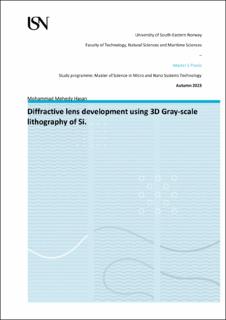| dc.description.abstract | Diffractive lens is a valuable choice in various optical applications, as they are light in weight and compact in size making them ideal where size and weight are crucial. This characteristic allows the design for more portable and efficient optical system, which can be made using wafer scale MEMS technology. Silicon is a suitable material for infrared optical applications as it is almost transparent in the 3-14 m wavelength range.
This study is dedicated to the fabrication of infrared diffractive lenses utilizing maskless 3D grayscale lithography of Si with the objective of achieving etching selectivities of 1 to 2. The investigation explores into the effects of various gases, including SF6, O2, and CHF3, on Reactive Ion Etching (RIE) and how changes in etching rates demonstrate in silicon (Si) and photoresist (PR) when different gas combinations are used. Achieving selectivities of 1 to 2 involves the use of SF6 and CHF3. Selectivity of 2, synonymous with a 4π phase profile, is realized with the gas composition of SF6 at 3 sccm and CHF3 at 20 sccm. This signifies that the structure of the diffractive lens etches twice as deep into the substrate compared to the PR. Similarly, selectivity of 1, means the diffractive lens structure and the PR structure are of same height and depth, is achieved with SF6 at 3 sccm and CHF3 at 40 sccm.
The study also uncovers different RIE relationships and clarifies the important contributing factors. While previous research in grayscale lithography and RIE etching had a predetermined selectivity of 1, it did not offer comprehensive insights into the unique effects of gases employed in the process. This study explores the generation of diverse structures using a direct write laser (DWL) and various RIE recipes to optimize the selectivity. | |
